"Some Experts Say"

A wonderful example of the dying art of “newspaper objectivity.” Gosh, it’s a conflict! Some people think that staring at a screen instead of the road while driving might be less safe; some other people think that the number of accidents won’t change if your state outlaws texting and emailing while driving. Thankfully we have been presented with both opinions and can now just sit here in silence.
Die Huffington Post (Or, Das Huffington Boot)

“The Huffington Post has just signed a deal with Spanish newspaper El Pais to produce… El Huffington Post. ‘I’m really excited about this partnering model,’ said Huffington, who also recently signed off on a French site (Le Huffington Post), with the Paris-based paper Le Monde.”
— We can laugh all we want, and we surely will, but there’s gold in them thar hills. Looking forward, of course, to Die Huffington Post(zeit).
Some Fellows Make Surprising Job Changes
Very excited to be joining @peretti, @scottlamb,@mattstopera & to hire some great reporters to build the first true social news organization
— Ben Smith (@benpolitico) December 12, 2011
If two’s a trend, then holy cow. Ben Smith is leaving Politico for Buzzfeed and Don Van Natta is leaving the Times for ESPN (after 16 years!). (Bonus: from just the other day, here is a Ben Smith blog post about Don Van Natta.) This means a thing, and it’s different from recent hires like “Tina Brown offering people oodles of money” or “Bloomberg View offering people oodles of money,” but I can’t put my finger on just what. In part, it’s that there’s no longer what was once so clearly a “pyramid” of desirable media jobs, with the Times right on top like the eye on the pyramid. (Ben could have gone to work for the Times years and years ago, if he’d wanted to; Don found it not necessary to carry on there.) In another part, it means that there are media organizations with money and smarts who are not quite what you expected they are — leaving lots of room for future surprises in the landscape.
The Worst Sounds In The World
by Matthew Newton
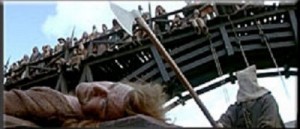
15. Death by electrocution, government sanctioned or otherwise.
14. Human or animal run over, hit, or maimed by a car.
13. Civil War surgeon amputating limbs.
12. Guillotine in use; subsequent lopping and dropping.
11. Monkey having its skull bashed open, brains eaten in the name of impotence-curing cuisine.
10. Cannibal chewing on his own penis.
9. Involuntary dual nipple piercing via meat hooks.
8. Bones breaking and/or cracking.
7. Disembowelment (not even Mel Gibson, Freedom!).
6. Human body ejected through the windshield of an automobile.
5. Drawing and quartering.
4. Reanimated corpse biting into your (or a loved one’s or a stranger’s) neck muscles, jugular vein or assorted sinewy tissues.
3. Hair torn from a scalp, human or otherwise.
2. Frenzied knife-stabbing-a-sandbag sound most often heard in cinematic prison shank scenes, except here.
1. Curb stomp.
Matthew Newton is the publisher/editor at Annals of Americus, a digital journal documenting art and culture in post-empire America. He tweets via @newtonmatthew; has a personal blog too.
How They Got There: A Conversation With Poetry Teacher Marty Skoble
by Noah Davis
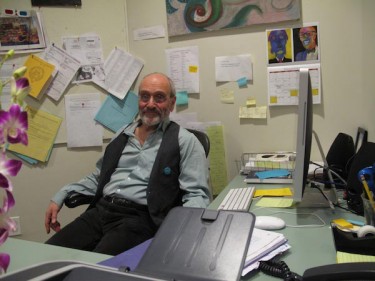
Marty Skoble sits in his office surrounded by the words of his students. Recently, one of his charges slipped a note under his door that read simply, “Waves look like white horses.” That is not the most advanced of similes, but consider the context: The uncertainty of the pensmanship suggests that the anonymous writer was in his or her first decade.
Skoble started teaching poetry at Brooklyn’s Saint Ann’s in the 1980s. More than 30 years later, the balding, bearded gentleman who speaks with the thoughtful cadence of a lifelong educator is an institution, meeting with every lower school student once a week and 400 children in total. In his beautifully cluttered office, Skoble talked about a life filled with poetry, children, and the occasional modern dance while his 18-month-old English springer spaniel, Slim, snacked on a bone her owner brought for the occasion.
How did you get here?
It’s half my life. I’ve been here 35 or 40 years. I started out as a college teacher. I was 23 when I started teaching at Brooklyn College. I grew facial hair so I could be separated from the majority of my students who were probably at least as old as I was. After a couple of years I was hired full-time at Queensborough College where I worked for 25 years. During that time, I was writing a lot of poetry and publishing a bit. I had a family. At some point, my life changed. I was living on my own and seeing the kids part time. I started teaching poetry workshops for adults. When my youngest son was in first grade here at Saint Ann’s, I invited his teacher to come to a workshop. Her response was, “Come and do one in my class.” I said I don’t teach kids. But she persisted, so I tried one. And it was so much fun. I went back the following year and did one a week, and it was even more fun.
The following year, she was leaving but the head of the lower school said he would ask if any other teacher wanted me. Gabrielle Howard said, “I’ll have him.” She is now the head of the lower school. I worked in her class. She is an amazing teacher. I took a sabbatical to spend full time in her classroom. I went back to college, but my time at Saint Ann’s grew. As Howard’s kids went into second grade, I started doing some second-grade workshops and then third grade. I started doing middle-school workshops and following those kids, and then suddenly I was doing high-school workshops. The number of hours I was spending here increased. I forced myself to keep working at Queensborough, but I was liking it less and less. Simultaneously with that was what I have to describe as a serious decline in public education in New York in the ’70s and ’80s. I had more and more students in my English classes at the college — I was teaching writing and literature — who couldn’t read. I couldn’t help them because I didn’t have the skills to teach reading or really the desire to teach it. So I took early retirement from Queensborough.
When was that?
1991. Before that, I was teaching four-fifths time at Saint Ann’s, but I didn’t have medical insurance. When I took early retirement, I needed that because the benefits didn’t kick in for a while. I teach 400 of the 1,000 kids at Saint Ann’s. I teach every kid in the lower school once a week. I have four middle-school workshops, and I have one large high-school seminar that’s split into two halves because there is no classroom that accommodates 40 kids. We just have a lot of fun and do a lot of great stuff.
You only teach poetry?
I only teach poetry. It is the writing of poetry that is my focus. Kids ask me all the time, “Are you the only poetry teacher?” And my answer is, “No, everybody at Saint Ann’s is teaching poetry.” And it’s true. You get poetry in English classes. You get poetry in history classes. You get poetry in what we call “language arts” here. Kids are reading poetry in Latin classes. But I’m teaching composition; writing the poetry as a special focus. That’s a little different. In middle school and high school, I do introduce model poems, and we talk about them, but the focus is on the tools those men and women are using.
You must be one of the only full-time poetry teachers.
I suspect there are a couple more, but I’ve only heard of one other at Milton Academy in Massachusetts. Without any official information and on the basis of rumor, I’ve heard that if you do poetry at Milton Academy, you can’t do other specialties. You have to dedicate to it. Here, I’m competing. Kids are doing theater and poetry, puppetry and poetry, art and poetry. They are doing all these other things, and all the sports.
I would be sitting in my office reading, and the boss would come by and say, “You can’t do that.” I would say, “Why? I’ve done my work. It’s on your desk.”
When you were looking at where you life was going to go, did you see yourself as a teacher?
I always wanted to be a writer. I think I knew that from infancy. I have a very distinct memory of drawing squiggly lines on a piece of paper, folding it, putting it in an envelope, putting squiggly lines on the envelope, sealing it, and dropping it in the mailbox on the corner. I’m not sure to whom I was mailing it, but I was sending out work before I could write. That’s a very clear memory. I remember doing this. So I think the answer is yes, I always wanted to be a writer. And I’m a very good writer, but I’m not a great writer. I have published work, but not a huge volume of it. I discovered that I loved teaching, and it became something that I really relished and cherished. I find the success of my students really rewarding. I’ve always been interested in the way people teach.
It was not something I ever thought of myself as doing. When I graduated college, I thought I was going to be a writer. I went to Europe, and I wrote and I wrote and I wrote. When I was done writing, it wasn’t so wonderful. It wasn’t anything I was going to be able to sell. So I went to work in insurance. Because I was an English major and a philosophy minor, I found a job drafting language for group annuity contracts for the Equitable Life Assurance Society. They wanted someone to figure out how to say things so no one could select adversely. The actuaries would figure out what the odds were — what they were willing to insure — and then we would have to write it out in language. The legal department would see if that would fly with the state insurance department. I was the liaison between actuaries and lawyers. It was really stupid work. I discovered I would do a week’s work in two days. So I started doing a week’s work in two days, and then taking the other three days and reading. I was going to go to graduate school, so I was also studying. I would be sitting in my office reading, and the boss would come by and say, “You can’t do that.” I would say, “Why? I’ve done my work. It’s on your desk.” He told me I had to look busy, and I told him he had to pay me more money to look busy because it was hard work. I may be the only person who got fired from an insurance company.
Saint Ann’s is a special place. There are no grades. It’s the type of school that could support a full-time poetry teacher. Is that a fair assessment?
Totally. Stanley Bosworth, who founded Saint Ann’s, adored poetry. He thought of it as a kind of bulwark of the civilization, one of the ways you transmit the culture. He was a very strong supporter of the arts, and he gave me carte blanche to go ahead and do this. Poetry is on the walls. It’s everywhere in the buildings. Everyone reads the poetry.
Our goal really isn’t to make everybody a poet — although Stanley once jokingly said he wanted to produce 20 percent of the American poets and he may have done it — but my goal is to create an environment where everybody is poetry literate. I taught poetry in college, but when I would introduce the poetry unit to my introductory English class, everybody would groan. Their response was, “I don’t get poetry.” We have kid’s parents here who say, “I don’t get poetry, but my kid does and I really appreciate that.” That’s what I’m about. I’m about creating an environment where you could write a poem if you wanted to, but you’re too busy doing organic chemistry. That’s fine.
I think that makes a lot of sense to expose kids to poetry.
Yes. And they write poems. I have a little pad on my door, and I find notes from kids. The other day a student left me a note that read, “Waves look like white horses.” Some kid came by, dropped off a simile, and left. [Laughs]
There is a poem of the day on Saint Ann’s website. I imagine that is your doing?
In the middle school and high school, all the poems are on the computer. I type the middle schoolers’ poems and bring them in so we can read them. In the high school, they send me their poems, and it creates a packet that we discuss each week. There’s this proliferation of poetry. I send them off to Mike Roam, who is the head of our computer sector. He set up a program where the computer loads them in and assigns them days. Each day, there is one poem of the day and three bonus poems, so there are technically four poems every day. On December 3rd, we will have reached 10,000 poems. We’ve only started putting them up in 2004, but I’ve been here since the ’70s. There is a huge amount of poetry being produced.
How many student poems do you read every year?
Oh God, I wouldn’t have any way to calculate that. Thousands, just thousands.
In a list of 25 things she wanted to do before she died, Caroline Hagood, a poet and writer living in New York, wrote “Build a shrine to Marty Skoble, the man who just knew that 5th graders could get poetry.” That’s a wonderful sentiment.
It’s a lovely thing Caroline wrote. I ran across that, too.
How did you know that kids would get it?
Accidentally. One day I went to Fran Greenbaum’s first grade class, and we did this little workshop. These kids could write these poems. It was a revelation. If first graders could do this, if kindergarteners could do this, then I could do it all the way through. I had been teaching about four or five years when Kenneth Koch’s book about teaching children got published, and he was doing exactly what I was doing. It was such an overt confirmation.
I’m about creating an environment where you could write a poem if you wanted to, but you’re too busy doing organic chemistry. That’s fine.
I heard you did some modern dance. Can you tell me a little about that?
It has to do with teaching. I was not a dancer. I was not really interested in dance, but I had a friend who was studying dance. One night he wanted to go to a dance performance of a group called Grand Union. This was in the ’70s. It was in a storefront art gallery. Everybody stood around and these four women danced contact improvisation. Something just happened. One of these women just mesmerized me. It’s hard for me to explain exactly what I felt, but my feeling was clear that this woman had something to teach me. It wasn’t sexual. It wasn’t desire, although she was very beautiful. Our eyes met and I knew that she had something to teach me. Steve knew her. I told him this, and he said, “Let’s go meet her tomorrow.” He trucked me off to her apartment. I was in over my head in this. I didn’t know what was happening or what this was about but I went with it. We sat in Barbara Dilley’s apartment, and I said, “I don’t know, but I know that you have something to teach me.” She said, “Okay. I’m going to be in Naropa this summer. Why don’t you come on out?” So, I went to Naropa. I lived in her house.
And she was totally cool with that?
She was fantastic. Suddenly, I was in the midst of Douglas Dunn, Meredith Monk and these great dancers, watching Barbara’s classes. I couldn’t really take them; I didn’t have any skill, any background, but I could hang out with them. I started photographing them. They started making a piece, and I started photographing them while they were dancing. I had to be on the dance floor to do it. I started walking around them while they were dancing and improvising. More and more of my movements became dance movements of a sort, inadvertently. When it became time for the performance near the end of the summer, they said I had to be onstage with the camera during the performance because I was part of the piece. So I became a dancer.
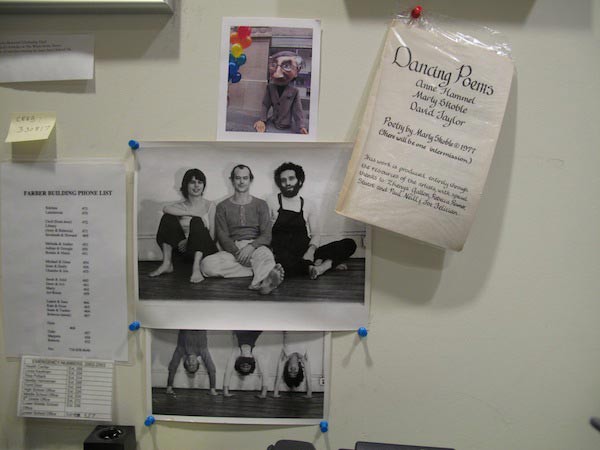
But what I was really there for was watching Barbara teach. I learned a huge amount from Barbara about improvisation and going with your instincts. A lot of what I do when I’m working with little kids is instinctive. When I approach a child to dictate a poem or to create poem, I know what to say. Or I don’t know what to say, but I say something anyway and it’s often unlocking the door. One of the things she taught me was that in dance there is no such thing as a misstep, there is only the next step. I took this stuff to heart. Between Gabe Howard and Barbara Dilley, I learned a lot about teaching. Although I was teaching before I met either one of them, I think I became a really good teacher — I’m afraid to say great teacher. Something happened during the course of those things that made me a much better teacher, a much more powerful teacher.
Did you do any of your own dancing?
When Naropa was over and when I came back to New York, I had become friends with some of the dancers in Barbara’s group. We started working together to make a dance ourselves. I began to take myself a little more seriously as a dancer. We worked with contact improvisation. We worked up a vocabulary of movements and a set of texts, all of which were my poems. Everybody learned all the poems in the set, and everybody had a vocabulary of movement, the way we related to each other: rolling off each other, rolling into each other, moving each other around. At any point, anyone could start a poem. Anyone could follow with a line or go backward or forwards in the poem. It was all just part of the vocabulary.
We worked on it for two years until we could all think like each other. We knew exactly where the other was going to be and say. It felt completely integrated. And then we performed it at St. Clement’s Church. We performed it at the Neill Gallery on Greene St. David Taylor and I also danced on the bar at the Ear Inn with all the beer mugs around. We started on opposite ends. We met in the middle, and we rolled around each other while we were reciting poems. That’s one of my claims to fame: I danced on the bar of the Ear Inn.
Are you still dancing?
No. After we danced, David went to medical school, and Ann went off to do her own thing because it was really too constricting. I didn’t have anybody else to dance with. I didn’t feel like I could go anywhere else with it. And I was happy. I had done what I wanted to do with dance. It affected me. It changed my life.
And I dance all the time. I dance at home a lot. In fact, I got married a year ago October. We celebrated it in April, and we danced on the table.
That’s great. It came full circle in a way.
Yes.
Okay, so who’s next?
Bill Walsh. He’s a chiropractor and a kinesthesiologist. He runs a place called the Plaza Center for the Healing Arts.
Previously: Author Robert Sullivan
Noah Davis is frequently lost.
When I'm Watching My TV And The Band Comes On To Tell Me How Delicious My Breakfast Cereal Can Be
https://www.youtube.com/watch?v=tiTyqYRE2vU
Did you know that the Rolling Stones made a television commercial for Rice Krispies cereal in 1964? I did not. But thanks to WFMU’s Twitter stream, I do now. And I’m glad for that. It was apparently co-written by Brian Jones. Also, it is Friday afternoon.
Here Is A Funny Essay To Buy
Do you like humorous essays that can be read on the electronic device of your choice? Then you should totally get Awl pal Sloane Crosley’s new Kindle single, Up the Down Volcano. There is a donkey on the cover! How can you say no?
Chicken & Waffle Popovers

My friend Matt is a great lover of bleach, guns, wigs, booze and chicken & waffles. And so, earlier this year when chicken & waffle cupcakes became a Thing On The Internet I knew without a doubt what we would be eating for breakfast on December 5th.
Every December 5, his birthday, the day goes something like this: At around 9 or 10 a.m., I scamper down the hallway to his apartment (even though we’re grown-ass adults we still choose to live dorm-style because it’s awesome) weighted down with packages and cupcakes and a bottle of bourbon. He makes coffee, into which we pour milk and Splenda and a goodly amount of that bourbon because I’m a “on birthdays anything goes” kind of gal and if we want to start drinking at 9 a.m. that’s what we’re gonna do. Go ahead and try to stop us, we’ve got bleach and guns. Then sometime around noon we decide that leaving the house might not be a bad idea and hey, are you a bit peckish? I’m a bit peckish. Let’s go get lunch and more drinks.
After lunch — so maybe by now we’ve made it to about 2 p.m.? — the siren song of International Bar becomes too much for us to resist and off we go for a few rounds of a Schaefer and a shot, which always seems like such a great idea at the time, doesn’t it? Oof. It is never a good idea and yet no one ever learns from their mistakes.
Generally by the time 4 p.m. hits we’re about pickled, which means, of course, that it’s time to go back home — sometimes we stop at Ricky’s on the way to try on wigs — and watch a movie about Rich White People. This year Six Degrees of Separation was up. Chaos, control; chaos, control.
Most years we’re passed out in bed by 7 p.m. It is the greatest day of the year as far as I’m concerned.
Right but: it all starts with cupcakes. Well, this might be the time to tell you that I’m not overly fond of cake in general and I’m doing this thing where I’m trying to be a little less do unto others and a little more do unto myself (it’s absolutely not working out well, in case you were curious; actually it’s been a disaster but that’s another story for another day) and honestly, I didn’t want to eat a damned cupcake. Plus, Matt is a hot sauce ’n’ honey kind of guy and I really couldn’t abide the notion of putting hot sauce in a cupcake batter. So I got creative and oh man, did it ever pay off: instead of building this mess on top of cake I went with a popover base and it was BANANIMALS.
Okay shall I talk you through how to do this for the Matt in your life? You got it!
Popovers
Are you aware that popovers are DUMB EASY to make and you don’t even need a fancy pan for them (though, of course, I have a fancy pan for them because I am a spectacular ass when it comes to premium cookware)? Seriously, a regular old muffin tin is all you need and who doesn’t have one of those? (Don’t tell me you don’t.) Anyway, maybe it was the equipment issue but for some reason I was always terrified of popovers and then one day I was just like, “ALRIGHT GIRLIE, TIME TO CONQUER THAT FEAR” and yeah, I was being really stupid because there’s nothing to be afraid of. I use the King Arthur Flour recipe, which I like because the King provides baking instructions based on what kind of pan you’re planning to use (like a large muffin tin, a regular one, a miniature one or a popover pan), as well as flavor suggestions, which is so thoughtful!
For this purpose, however, I wanted to jack things up with hot sauce, so my recipe looked like this:
(1) Whisk together four eggs (room temperature, or as King Arthur suggests, bathe them in a bowl of warm water for 10 minutes before cracking), a cup and a half of milk (any kind!), a half teaspoon of salt and a teaspoon of Tabasco sauce. A teaspoon of Tabasco will give the popovers a pretty decent but definitely not overpowering kick, though I must warn you that I’m a great abuser of hot sauce (I put it on my bagels, is that weird?) so you need to take that opinion with a grain of cayenne and adjust as necessary to suit your mouth.
(2) Dump in a cup-and-a-half of flour and whisk until there are no large lumps. Small ones are fine.
(3) Stir in three tablespoons of melted butter.
That’s it! I know, right? DUMB EASY. The baking instructions depend on what kind of pan you’re using, but if you’ve got a popover pan you want to bake them at 450 for 20 minutes before dropping the temperature to 350 and baking for an additional 15–20 minutes. The cups should be filled about ⅔ of the way up with batter. Two super super super important things about the baking process: the oven must be properly up to temperature and you mustn’t open the oven door to peeksies while they’re popping over.
Honey Buttercream Frosting
Another requirement of this custom designed batch of notcakes was that honey be a key player. Easy. So easy it’s almost an insult. Honey buttercream frosting done and done and done: using a hand or stand mixer, beat together one stick of softened butter with four tablespoons of honey and one cup of confectioner’s sugar. (If you’re sugar-averse, start with half a cup of sugar, and move forward, while tasting.) Do that for, ooooh, three, four, five minutes or so? Then check the consistency and depending on how things are looking beat in another half to full cup of confectioner’s sugar.
To Assemble
Because I’m a person who loves to cook and feed and write about cooking and feeding, I would encourage you to make your own fried chicken. It is also easy. However, the birthday boy is tremendously fond of Popeye’s chicken and actually specifically asked if I would use Popeye’s and sure right of course you’d like me to save myself the time and hassle and clean up involved with making homemade fried chicken? YOUR WISH, MY COMMAND, ETC. So to assemble these, I frosted the popovers and then stuck a couple of Popeye’s chicken nuggets on top of them. We decided that function trumped form in our case, and frosted the popovers while they were hot, which made for an absolute mess, but a delicious mess that neither of us minded at all. (Also we were pretty well on our way to tanked by the time this happened and would have made a mess in some way, shape or form no matter what we did.) If you’re concerned with presentation (AKA, not drunk) let the popovers cool before you frost them. Pro tip from the King: If you can do so without the popovers getting too dark, bake them for an extra five minutes, which will help them to retain their popped shape even after cooling. This is where, if you were really loaded, you could cut up some WAFFLE CUBES and spike them on top with the chicken — but truly the popovers and the frosting are enough bread-syrup substance for anyone.
To Eat
There’s a great thing that happens when you bite or tear into a popover laden with stuff: everything collapses inward, landing in the hollow part of the popover and then you can kind of turn it into a sandwich, if a sandwich were covered in melted honey butter? Right. Just be prepared to be covered in frosting.
Jolie Kerr doesn’t really know how to stop doing nice things for people but if it involves being covered in frosting she guesses it will all be okay somehow. Amazing photo by Jason Lam.
Cronenberg's 'A Dangerous Method': The Way We Rut Now
by Maria Bustillos and David Roth
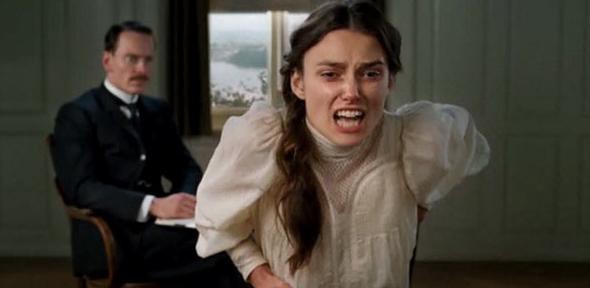
David Roth: A film about Sigmund Freud and Carl Jung and ostensibly weird sex, from a director who has spent his career making films about how terrified/fascinated/aroused/disgusted/disgusto-roused humans are by their bodies and what they do and the horrible things that come out of them. So why, Maria Bustillos, would the two things I remember most from A Dangerous Method be 1) how cruel my female friends were about Keira Knightley’s breasts and 2) the nagging question of whether David Cronenberg is trying to make interesting movies anymore?
Maria Bustillos: A film worth seeing, I thought — though not one worth talking about until after, so I’m glad we waited. I suspect that Cronenberg is going for “edgy” more than interesting. But the ethical underpinnings here are vanilla in the extreme. (Also: it is always refreshing to see a woman in a movie who hasn’t been made to look like a Bratz doll.)
DR: It’s just strange to get something this stodgy from the guy who spent his first two decades of movie-making finding new ways to turn teeth into guns that, like, shoot penises at people. That dude is now the guy who made a movie in which Freud, whose turf he has been working for decades, actually appears as a character, but which is also somehow totally free of any actual perversity or perversion or life.
MB: So you liked it, then.
DR: Eh, more than I’m letting on, I guess. I felt some feelings at the end, surprisingly, and I’d definitely rather watch a movie about psychoanalysis and its discontents than watch a rich-people-get-sad opus like The Descendants. But mostly I kind of thought it was inert and crummy-looking and pretty silly and abstract in the way it dealt with sex and sexual guilt. Sexual gilt, I almost wrote. It’s kind of amazing how, given that Freud is a character in the film and author of the idea that everything we think, feel and do is based on some reaction to our feelings about our genitals, their output and/or poop, how clean it all was.
MB: Well, that was the idea, maybe? They’d been hiding the dirt, before.
DR: It’s just that they even when they got dirty, they didn’t get dirty. Okay, the movie is, spoiler/diligence alert, about a conflicted psychiatrist (named Carl Jung, looks like Michael Fassbender) dipping out on his pregnant wife to spank/hump a brilliant patient named Sabina Spielrein (played by the lovely and pointy actress Keira Knightley) who rattles his saber, and how that experience leads him to fall out with his idol, who is the father of psychoanalysis, who is Sigmund Freud and who is played, because of course he would be, by Viggo Mortensen. There is spanking and humping and conflict, but everyone is so meticulously (and constantly) costumed, and there’s zero sense of place — lots of horse-and-buggy action on brightly lit, cleanly scrubbed streets, with like two parasol’ed extras walking around in the background. That and those super-upholstered living rooms.
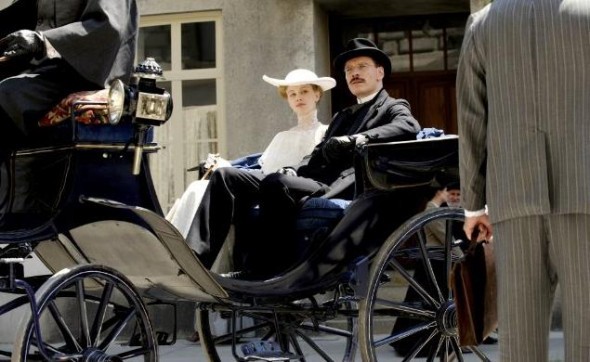
MB: I thought the claustrophobia in this was deliberate, for what that’s worth. The beautiful lustre of these objects, furniture, horses, people, was meant to be like the public face of things: underneath, the corsets and the spanking. The real, so-called “dangerous” part, like a siren song. Though Miss Knightley appears to have modeled the early bits of her performance on the monster in Alien. I almost expected extra sets of jaws to come out of there.
DR: Man, that mandible. When she gets that chin-jut popping it’s some H.R. Giger shit for real.
MB: They were definitely going for a vagina dentata thing, I thought, didn’t you?
DR: Yeah, her teeth — imperfect teeth, improbably — get a lot of play.
MB: They be snappin’. Really, the whole movie is about her mouth. The Truth is In There. (By the way, German “spiel” = “to play,” “rein” = “pure, chaste, uncorrupted,” interestingly.)
DR: The relentless Freudian tooth-play was, to me, one of very few Old Interesting Cronenberg things in the movie. The new, soundstage-y, Everything Just Looks Really Canadian Cronenberg did the rest.
MB: Maybe the teeth are the danger, and that is why one must safely plow the fertile fields of Madame instead. The wee wifey who Doesn’t Want to Know. So creamy, so rich, so sumptuously bedecked. She is like a walking confection, especially at first.
Presumably there is so much fuckpower in a chaste, chilly forehead kiss from Michael Fassbender that it can cause spontaneous reproduction.
DR: Ah, the poor wife. How she keeps getting pregnant is one of the movie’s great mysteries. Presumably there is so much fuckpower in a chaste, chilly forehead kiss from Michael Fassbender that it can cause spontaneous reproduction. Of course, his actual sex scenes weren’t appreciably more engaged.
MB: I loved the way these gorgeously-attired specimens would be so distantly intoning this and that about “were you masturbating,” and whatnot. I thought it was what they were trying to get at, really, how you can keep “civilization” intact in the face of these uncontrollable forces. But that didn’t quite work out.
Because yes, I did not get the idea that Fassbender’s Jung was in the throes of sexual obsession, not really.
DR: It’s that mustache. He has a chipmunk sleeping under his nose all movie.
MB: Wake up, Alvin!
DR: Hard to convey heatedness with that drowsing animal up there.
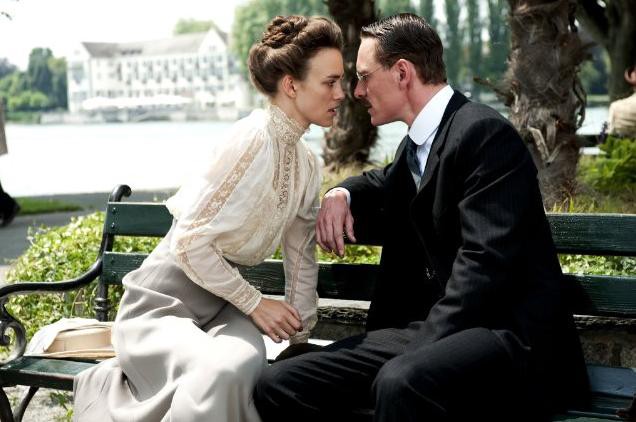
MB: But in contrast to what we heard from Choire last week though, the male lead in the movie managed to consummate, finally. Bravo, Fassbender!
DR: I’m going to find him and fist-bump him. “Bro: nice one.”
MB: Oh, man.
DR: That big set-piece sex scene was interesting in that they were both clothed, I guess. As was presumably the convention at the time. In England, they wouldn’t even have been in the same room.
MB: He is dressed all the time, yes. I can’t imagine that skin-hunger would have been any different, but okay. I suppose that, for him, we’re meant to think that this may be coitus but it is not a physical matter, I reckon. It’s an intellectual penetration, an investigation — here she’s been telling all these strange truths — rather than the kind of ecstatic renunciation of self that we hear about later, but from her, and it comes as a surprise to the menfolk. So this is all deliberate.
But it’s also right where Cronenberg loses me, because he seems to believe that the physical world really is filthy and degraded, cf. The Fly, though in this movie he opposes the filth with this cerebralized non-romance. Which is just as bonkers in its own way, as that “naughty,” “dirty” thing. Equating filth, lust, the physical plus, in this case, insatiable curiosity and the irresistible desire to lift the rug. What do you think about this, equating the irresistibility of curiosity with the erotic impulse?
DR: I think I could’ve gone along with it if I’d gotten the sense that anyone was ever actually turned-on. Besides Keira, who is very twitchy but I guess does at least seem to be enjoying herself. But if Jung had turned to the camera and said, “Fascinating, really” during any of the sex scenes, it wouldn’t really have been all that jarring.
MB: My dissatisfaction with the movie and with Cronenberg’s work generally is rooted in this really flat duality, where the only truth is the “unconventional” one. For reals I could have done with more of the tormented history of psychoanalysis and less of the sexual-gilt (!).
DR: Especially because, for a movie that’s being sold in part for its sex, it manages to whiff on both what’s fun and scary about wanting and not-wanting-to-want. In A History of Violence, which I thought was total puffed-up, pretensio graphic-novel doofiness, there are these two weirdly intimate and jarringly natural sex scenes that are the only emotionally authentic moments in the film; something like that would’ve helped so much, here, just in terms of perking everyone up and puncturing the Masterpiece Theatre vibe. Instead, there’s no sense of lust (or what’s fun about it) and no real sense of the stakes for the people involved. Which, to reiterate, are a rich Aryan doctor in 190-whatever Switzerland and his patient/spank-bud, a younger unmarried Jewish woman. So it’s a biggish thing to miss.
MB: They never get that right, the shame. We have a sense of the sordid, but in order to get to the shame you have to have some real conviction of what the sordidness has betrayed. Plus, they missed on the eroticism part, the sense of it is just the two of us in our own world. It was almost like the spanking was part of her treatment, a way to “help,” which really kind of gnarled me a bit, how detached and clinical it seemed, when it was also supposed to symbolize The Fall, in another way. I say this though I am an Ibsenist through and through. But without a sense of the sacred, there can’t be shame.
DR: I agree with that, but because this is supposed to be a good and more to the point intriguingly weird filmmaker — not some costume-y doofus, but a guy who spent the first two decades of his career basically taking Freud-o nightmares on film and having them chase a hungover Oliver Reed around — I had to wonder if some of that wasn’t intentional? To what degree do you think the incredible, high-collar artificiality of the movie was conscious?
MB: I got the impression it was like, look how much effort these people expended on sanitizing our inescapable physicality, lust, decay etc. Hiding reality under this glossy veneer. The story we were expected to see, I think, was that the guy Gross…
DR: Ah, Otto Gross. Vincent Cassel just Vincent Cassel-ing everything in sight. Same turtleneck sweater in all of his scenes, definite sense that he smells like coke-mouth and onions and older ashtrays.
The only way you can tell that Fassbender has reached the summit of ecstasy is that he looks a little worried.
MB: … yikes, right, that this seductive, no-brakes character understood better than Jung did that Freud’s technique, here called just the “talking cure,” would open up myriad temptations, drag the doctor into experiencing the world through the patient’s eyes or rather, through her mind. The truth, right? These “sick” people are closer to the truth, we’re being told, I thought. “Facing reality.” In this way, Jung would be tempted into the real world and away from the falsely clean, aestheticized Victorian Potemkin Village ’n’ Gift Shoppe. The real world will surely drive you mad — you’ll have lust, you will no longer be creamy and correct, you’ll feel pain and get dirty and be a naughty, naughty boy. “Civilization” being a purely artificial, pasteboard confection behind which is the real sweating, violent, lusting mud and blood reality, or something like that.
MB: The trouble is, I have little sympathy for these views, they seem kind of adolescent to me. I go in for more like both/and, not either/or. An alchemical balance is what gets us closer to reality, and to peace, not some crazy dichotomy of like filth/sex vs. cleanliness/chastity.
DR: And whose dualities are those, anymore? Many people, I guess, but this movie’s audience’s? I can believe that sexuality was a far scarier and less extravagantly commodified thing than it is now, but what are we learning or feeling about sex from a movie that’s so heatedly scientific in talking about sex, and so fucking buttoned-up once it finally gets down to it? The degradation stuff — there’s a lot of mud and trembling crazyface shame from Keira K. — is cartoon, but the actual exalted/enjoyable aspects of it are so distant.
MB: The movie did not even begin to fathom the idea of exaltation of any variety at all.
DR: It doesn’t just leave its socks on, it leaves its pants and suspenders and shirt and fucking borsalino on. It loosens its tie.
MB: Gets off, but just barely. The only way you can tell that Fassbender has reached the summit of ecstasy is that he looks a little worried.
DR: Immediately looks around and begins small-talk. “What a lovely lamp.”
MB: “Is that Michelin lace on your pantaloons?”
DR: Everyone is either thinking about lunch or experiencing orgasm.
MB: Not both, surely?
DR: “Arby’s superfan Michael Fassbender was arrested again today…”
MB: Another thing, a significant thing, is that bits of the story are historically accurate but there is no real indication anywhere about the spanking and whatnot, nor is there even absolute confirmation that Spielrein and Jung were lovers. It is a little disingenuous to mix it up this way, as the director and actors have even been doing in interviews and stuff.
DR: The movie also seems kind of hilariously unfair to Mortenson-as-Freud. It’s one thing to take the handsomest dude out, put a fake nose (I think?) on him, give him some plummy European Person Accent, and have him analyze someone else’s dreams from behind a cigar all movie. It’s a silly thing, given how much more complicated a human he must have been, but that’s one thing. It’s another to turn him into this paranoid prig. Which he may well have been, but I just have to imagine he was a lot more interesting in how he was angry.
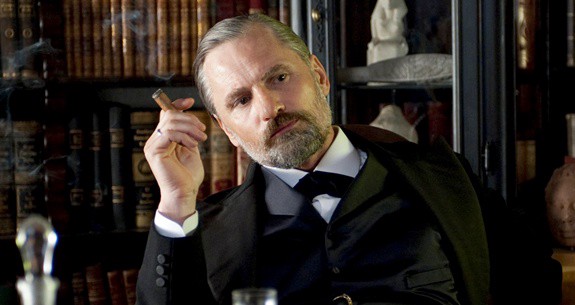
MB: He turned out to be this complete cipher! Whereas the real Freud was forever emoting and raging and sliding to the floor in a faint. Though to give Cronenberg credit, the movie does kind of glance at the impossibility of having literally everything be about sex, how difficult this made things for the early psychoanalysts. And even now, there are still all these factions; the early schisms have never been resolved completely.
DR: It’s also odd that what they make Freud seem petty about is a perceived anti-Semitism. He gives Keira some real-talk, can’t-trust-a-gentile spiel, which is funny because it is the two handsomest and least-Jewish-looking people on earth having the just-between-us-Jews talk, but which was also a miss in that the movie never examined whether or not he was actually right. Without context, it makes Freud look small and paranoid and a bit of a bigot. But given Jung later in life associations with some very anti-Jewish people (however passive or overblown those were, they’re still a part of his story), it would seem worth mentioning.
MB: I thought so, too, about the small-mindedness of Freud. That was where they really started missing the boat.
DR: And what a missed opportunity that is. Because Freud, even in context, is WAY out of context. Just ideas from nowhere at that point.
MB: Here the guy had just found an ocean, or like, a planet, that had been right in front of everyone, and he was really the first one to see it. There was NO sense of this. (By the bye, I do recommend Ernest Becker’s Denial of Death if you want a clearer account of what happened between Freud, Jung, Adler, Rank & co., plus Becker is practically the greatest genius of the 20th c.)
DR: And Jung, too, breaking with that, was very bold. That’s a big and interesting story, albeit one with less spanking.
DR: The letters that take up like 20% of the film’s dialogue were the actual letters between the three, I think. And those are good. Certainly they’re the things that come closest to delivering the goods on what must have been a very complex relationship/rivalry/friendship between Jung and Freud.
MB: Really, I didn’t know. The paper, the ink, the language, the writing. Very beautiful. Here is the means by which these people were able to insulate themselves from the crazy shit they were talking about.
DR: I think we can agree that this is, if nothing else, an incredibly well-insulated movie. I think maybe, if we wanted to get at Sexual Intercourse and Its Discontents, we should’ve seen Shame.
Maria Bustillos is the author of Dorkismo and Act Like a Gentleman, Think Like a Woman.
David Roth writes “The Mercy Rule” column at Vice, co-writes the Wall Street Journal’s Daily Fix, and is one of the founders of The Classical. He also has his own little website. And he tweets inanities!
